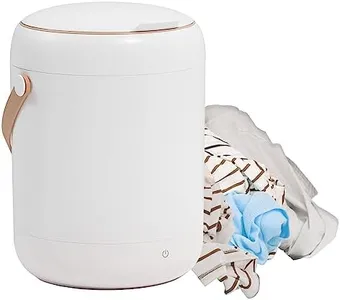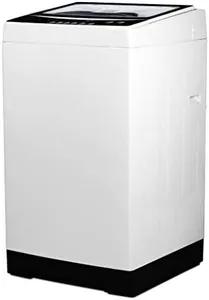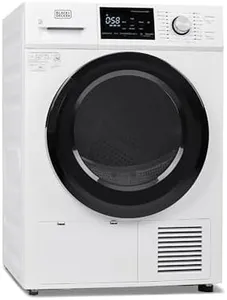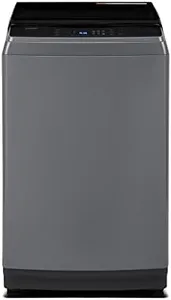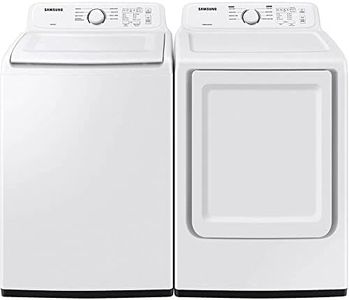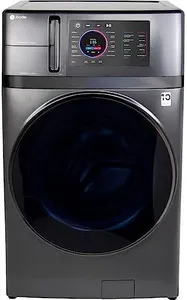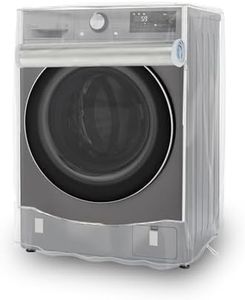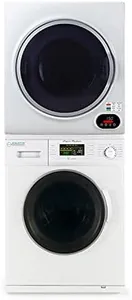7 Best Washer And Dryers 2025 in the United States
Our technology thoroughly searches through the online shopping world, reviewing hundreds of sites. We then process and analyze this information, updating in real-time to bring you the latest top-rated products. This way, you always get the best and most current options available.

Our Top Picks
Winner
BLACK+DECKER Small Portable Washer, Washing Machine for Household Use, Portable Washer 2.0 Cu. Ft. with 6 Cycles, Transparent Lid & LED Display
Most important from
7767 reviews
The BLACK+DECKER Small Portable Washer offers a compact design with a capacity of 2.0 cubic feet, suitable for small households or those with limited space. It can handle up to 15.4 lbs of laundry per load, which is quite impressive for its size. The washer comes with six cycle options including Normal, Heavy, Delicate, Quick, Bulky, and Spin Only, providing flexibility for different types of laundry, from baby clothes to bulky items.
The stainless steel tub is durable and resistant to rust and corrosion, enhancing the product's longevity. Additionally, the washer features an LED display, three water level choices, and temperature settings (Hot, Warm, Cold), which add to its usability. Its noise level is 72 dB, which might be noticeable but manageable in most settings. The washer also includes smart safety features like auto unbalance detection, auto shutoff, and child lock protection.
The appliance's mobility is a standout feature, thanks to its rollers, side handles, and adjustable leveling legs, making it easy to move around. However, its 79.4 lbs weight might still be a challenge for some users when transporting. This washer is a great option for those looking for a portable solution with a decent load capacity and variety of washing options. It is particularly suitable for small apartments, dorms, or RVs.
Most important from
7767 reviews
BLACK+DECKER 4.4 Cu. Ft. Electric Dryer with Heat Pump, 22 lb. Capacity , 240V Electric Clothes Dryer with 16 Cycles, Without Outside Exhaust, BDFH44M, White
Most important from
2289 reviews
The BLACK+DECKER BDFH44M Heat Pump dryer is a compact and energy-efficient ventless option suited for those living in apartments or homes without external exhaust systems. With a generous capacity of 4.4 cubic feet, it offers plenty of space for laundry, making it a good fit for small households or individuals.
One of its standout features is the 16 drying cycles available, including options for different fabrics and needs, allowing you to customize your drying experience. The heat pump technology uses 28% less electricity compared to traditional dryers, saving you money on energy bills over time. Additionally, its sensor dry technology optimizes drying times by automatically adjusting based on moisture levels, ensuring that clothes are dried efficiently and reducing the risk of over-drying.
The stainless steel drum adds durability and helps maintain the quality of your clothes over time. The option to program drying selections up to 24 hours in advance is a big plus for those with busy schedules. However, the drying process can take longer compared to conventional dryers, which might be an issue if you often need laundry done in a hurry. Noise level is also something to consider; while not overly loud, it may still be noticeable in a quiet setting. Its ventless nature requires regular maintenance to empty the water tank, which could be an inconvenience for some users.
Most important from
2289 reviews
COMFEE’ Washing Machine 2.4 Cu.ft LED Portable Washing Machine and Washer Lavadora Portátil Compact Laundry, 8 Models, Environmentally Friendly, Child Lock for RV, Dorm, Apartment Magnetic Gray
Most important from
7870 reviews
The COMFEE' 2.4 Cu.ft Portable Washing Machine is a compact solution ideal for individuals living in small spaces, such as apartments, dorms, and RVs. Its main strength lies in its energy-efficient design and powerful washing capabilities. With features like the AUTO CLEAN and Hygiene+ mode, it effectively removes dirt and ensures a hygienic wash with multiple rinsing cycles. The Turbo Wash technology offers a faster cleaning process without sacrificing quality, making it a time-saver for busy users.
In terms of capacity, the 2.4 cubic feet may be on the smaller side, which means it may not be suitable for larger families or heavy laundry loads. However, for singles or couples, it strikes a balance between size and efficiency. The design is also very user-friendly, featuring a child lock for safety and a soft close door that minimizes noise when opening and closing.
The noise level is rated at 62 dB, which is relatively quiet, but some users might still find it a bit noticeable in peaceful environments. The machine’s stainless steel and glass construction gives it an attractive look, but it also adds to the weight, coming in at 88.2 pounds, making it less portable than some might hope. The smart features include an LED display and a compact design that is easy to integrate into limited spaces. The warranty is decent at one year.
Most important from
7870 reviews
Buying Guide for the Best Washer And Dryers
When it comes to picking the right washer and dryer, it's important to consider your specific needs and preferences. There are many factors to take into account, such as the size of your household, the types of fabrics you frequently wash, and the space you have available for the appliances. By understanding the key specifications and how they relate to your needs, you can make an informed decision that will serve you well for years to come.FAQ
Most Popular Categories Right Now
